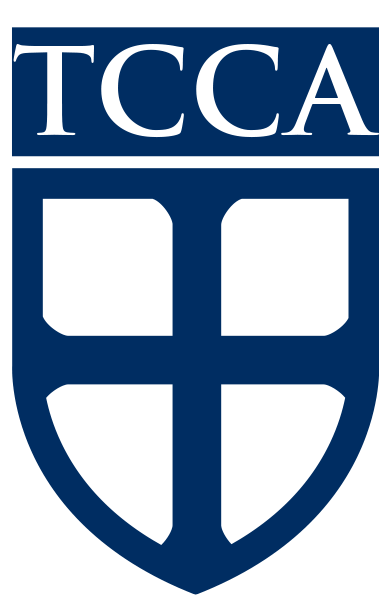Two-Year Old Program
Two-year-olds are constantly in motion and they use their natural curiosity for hands-on discovery. Two-year-olds need a rich learning environment that develops their cognitive skills and expands their vocabulary. By this stage in their development, routines and schedules become a big part of a child’s day. This promotes stability and security.
Potty training is a familiar theme with parents of a two-year-old. With this in mind, the TCCA staff will partner with the parents to help reinforce efforts being taken at home to potty-train their child. Please keep in mind that one of the criteria to enter the three-year-old program is to be 100% potty-trained.

The Creative Curriculum serves as the framework for conducting the TCCA 2-year-old program. Learning Environment Centers are introduced in the 2-year-old classroom and include: Bible time, circle time, dramatic play, art center, blocks, fine motor skills, music, and a book/literacy area. Every child will participate in activities that are socially, physically, intellectually, and psychologically age-appropriate. Children learn through action, exploration, and play. Our skilled teachers are adept at turning playtime into learning activities. New items are periodically introduced to facilitate a better understanding of the classroom’s weekly focus.
Extracurricular activities include but are not limited to chapel time, physical education, music and movement, art, library, story-time sessions, science/discovery classes, and Spanish.
Program Features
- Low student-to-teacher ratio.
- Supportive, nurturing, and professional care in a Christ-centered environment.
- Monthly thematic activities purposely designed to engage and enrich the child’s natural curiosity.
- Focus on learning concepts appropriate for the age group.
- Regular communication between teachers and parents to keep parents informed about their child’s day.
Criteria to enter an Two-Year old Program
- Children must be 2 years old before September 1st of the year entering the program.
- All age appropriate immunizations must be current.
FAQS
This is the year when we begin assisting you with potty training your child. Below are some helpful tips we have found help make the transition a smoother one. Please do not hesitate in coming to us if you have any further questions or need further clarification.
Things you can do at home:
- Start reading potty books and talking about going potty in the big potty.
- Have them sit on the potty during natural transition times (before and after meals, before and after naps, before diaper changes, before bath time).
What to do during training:
- Children should wear easy on and off pants during training, and no onesies.
- Pull-ups are a transition item from diaper to underwear. Once pull ups stay dry for an extended amount of time then we can try underwear with a pull up over it.
- Keep communication open with teachers as to how potty training is progressing at home.
What to expect:
- Sometimes children regress with potty training after they first start.
- Children may become fully potty trained at home before they are ready at school.
- Treats are a good incentive for potty training, please bring in something your child would like (gummies, small M&M’s, stickers, stamps, etc.)
Characteristics of a potty trained child:
- Able to indicate to an adult the need to go potty and/or is able to respond when asked to use the bathroom.
- Able to effectively pull down their own clothes and undergarments and then pull them up again after they have gone to the bathroom.
- Able to assist with the changing of their clothes if a potty accident should occur, which from time to time, may happen while napping.
To abide by Health Department guidelines and in order to maintain a sanitary classroom environment, children who are consistently having accidents must remain in a diaper at school.
We look forward to partnering with you this year and assisting you and your child on this next journey in their lives.
Fruits: Cut to Bite Size
Apple Slices
Bananas
Grapes
Melon
Peaches
Pears
Pineapple
Tropical
Orange (peeled & sectioned)
Blueberries or Raspberries
Fruit Cocktail
Honeydew
Cantaloupe
Watermelon
Sliced Grapes
Ripe Apricot
Kiwi
Meats: Cut to Bite Size
Chicken/Nuggets
Ham
Hot Dog
Meat Sticks
Meat Balls
Turkey
Fish/Fish Sticks
Cubed Chicken
Sushi
Rolled Meats & Cheese
Lunchables
Pizza
Veggies: Cut to Bite Size
Beans
Carrots
Corn Kernels
Green Beans
Mixed Vegetables
Peas
Potatoes
Tomatoes
Veggie Salad
Cherry Tomatoes
Corn Niblets
Avocado
Well-cooked diced Carrots
Cooked Potato Cubes
Cooked Zucchini or Squash
Cooked Asparagus Tips
Well-cooked Broccoli Florets
Cucumber
Hot (Thermos) or Cold: Cut to Bite Size
Muffins
Cereals
Crackers
Macaroni & Cheese
Ziti or Rotini Pasta
Pizza Rolls
Chef Boyardee
Chili
Rice & Beans
Pasta Noodles (w/ sauce)
Pasta or Potato Salad
Bagels (w/ Cream Cheese)
Toasts w/ All-Fruit Spread
Waffle
French Toast
Sandwiches: Cut to Bite Size
Peanut Butter & Jelly
Peanut Butter & Banana
Peanut Butter & Honey
Grilled Cheese
Wrap
Tuna, Chicken & Egg Salad
Miscellaneous: Cut to Bite Size if Needed
Yogurt/Gogurt
Cheese (slices, sticks or cubes)
Applesauce/Pouches
Cereal Bars
Granola Bars
Rice Cakes
Jell-O Cups
Pretzels
Hard Boiled Eggs
Graham Crackers
Cheerios
Fabulous Finger Foods by Sally Kuzemchak, R.D. in the October 2006 issue Parent Magazine
**Some of the items that are listed came from this article

